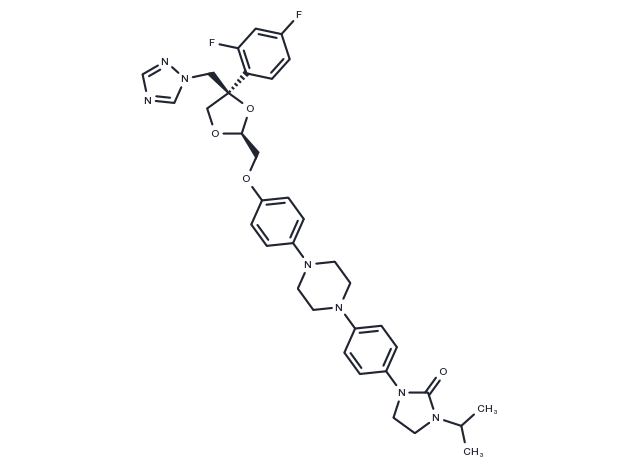Powder: -20°C for 3 years | In solvent: -80°C for 1 year


Pramiconazole (R126638) is an orally available antifungal compound.Pramiconazole is a candidate for the treatment of dermatophytes and cutaneous yeast infections in seborrheic dermatitis.

| Pack Size | Availability | Price/USD | Quantity |
|---|---|---|---|
| 1 mg | In stock | $ 543.00 | |
| 5 mg | In stock | $ 1,210.00 | |
| 10 mg | In stock | $ 1,630.00 | |
| 25 mg | In stock | $ 2,390.00 | |
| 50 mg | In stock | $ 3,260.00 | |
| 100 mg | In stock | $ 4,380.00 |


| Description | Pramiconazole (R126638) is an orally available antifungal compound.Pramiconazole is a candidate for the treatment of dermatophytes and cutaneous yeast infections in seborrheic dermatitis. |
| In vivo | This study was performed in 2 groups of subjects suffering from seborrheic dermatitis. The first group (n = 17) remained untreated and was used as a control. Clinical, mycological, and metrological assessments were performed at inclusion and during the following 2 weeks. The second group of subjects (n = 10) received a single 200-mg oral dose of pramiconazole at inclusion. Clinical, mycological, and bio-metrological evaluations were performed before and during 1 month following the single antifungal intake. For both parts of the study, several parameters were assessed including yeast density, desquamation, erythema, itching, and sebum excretion. Results: In the control group, no significant changes were observed in any of the parameters during the observation period. The findings were markedly different in the pramiconazole-treated subjects. The yeast density was significantly improved on days 3, 7, and 28. Desquamation, erythema, itching, and the global clinical evaluation as assessed by the patients and investigators significantly improved on days 7 and 28. A trend in the decrease of scaliness was noted. No effect on sebum excretion was evidenced. In conclusion, a single 200-mg dose of pramiconazole exhibits in vivo efficacy in controlling some important clinical aspects of seborrheic dermatitis. Following a reduction in the number of yeasts on day 3, a decrease in the severity of clinical signs and symptoms occurred from day 7 onwards. Sebum excretion appeared uninvolved in the clearing process of seborrheic dermatitis. A single 200-mg dose of pramiconazole appears to abate seborrheic dermatitis. The density in Malassezia present on lesional skin is first decreased, followed by clearing of the clinical signs.[3] |
| Synonyms | R-126638, R126638, R 126638, Azoline |
| Molecular Weight | 659.73 |
| Formula | C35H39F2N7O4 |
| CAS No. | 219923-85-0 |
Powder: -20°C for 3 years | In solvent: -80°C for 1 year
You can also refer to dose conversion for different animals. More
bottom
Please see Inhibitor Handling Instructions for more frequently ask questions. Topics include: how to prepare stock solutions, how to store products, and cautions on cell-based assays & animal experiments, etc.
Pramiconazole 219923-85-0 Microbiology/Virology Antifungal R-126638 R126638 R 126638 Azoline inhibitor inhibit
